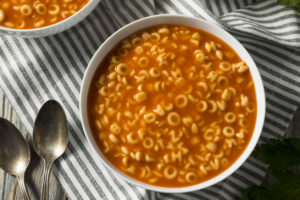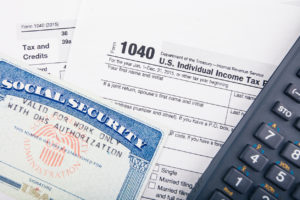
With only a couple weeks left in 2018, you are running out of time to take Required Minimum Distributions (RMDs) from your IRA. If you are an individual who likes to do charitable giving at the end of the year, this article highlights a strategy that you should consider.
The IRA Alphabet Soup

At times, discussions on Individual Retirement Arrangements (IRAs) can seem like you are looking at a bowl of alphabet soup. Here is a quick run-down of the terms.
Required Minimum Distributions (RMDs)
Think of these accounts as a partnership between you and the government. The government is kind enough to let you “borrow” their money in your investment account. Or that is the case until you reach the age of 70½. At that point, the IRS gives the timeout signal and requires you to take out a minimum amount each year. Of course, any money that comes out of your IRA is taxable. You didn’t think the government would let you off the hook for that loan, did you? The IRS calls these mandatory withdrawals Required Minimum Distributions (RMDs). But what if you don’t need or want to take money from your IRA. Too bad. These withdrawals must come out of your IRA. And you must pay taxes on those withdrawals. If you don’t make the withdrawal, the amount can be subject to a 50% penalty!
Qualified Charitable Contributions (QCDs) to the Rescue
For some seniors, the additional income from RMDs can have a negative impact. It can increase taxes owed on Social Security and the amount paid for Medicare premiums. Charitable giving is one way you can help lessen that impact. If you give to nonprofits already and are required to take RMDs, you should look into Qualified Charitable Distributions (QCDs). QCDs are donations made directly from your IRA to a nonprofit. QCDs count toward your RMD amount. Although QCDs count as withdrawals from your IRA, they show as non-taxable income on your tax return!
How it Works
Here is a simple example to explain how QCDs work. Let’s say you turned 70½ years old on June 1, 2018 and your IRA was worth $500,000 on December 31st of last year. Your RMD for 2018 would be about $18,250. Remember, any amount withdrawn from an IRA is considered ordinary income for federal tax purposes. If you make a Qualified Charitable Distribution of $8,250 to a nonprofit, you still would report $18,250 of income. But only $10,000 of that amount would be taxable. The QCD amount of $8,250 won’t be taxed. Depending on your tax situation, the result could be a large tax savings.
One More Thing
A couple of things to remember when it comes to QCDs. First, you must be 70½ to take advantage of this strategy. Second, the most you can do in QCDs in one year is $100,000.
The Death of Itemized Deductions
Over the past year, the tax law has had many significant changes. The change that impacts the largest number of people is the combining of the standard deduction and personal exemption. Howard Gleckman at the Tax Policy Center anticipates that the number of itemized filers may drop by 56.7%. For most married seniors, the standard deduction for 2018 is $26,600. This amount may be more than their itemized deductions. In those cases, they will no longer itemize. And charitable giving will receive no additional tax benefit. This is another reason to use QCDs for your charitable giving. Even if you take the standard deduction, giving from your IRA can provide additional tax benefits!

Measure Twice, Cut Once
If you have decided that a QCD is right for you, there are a few things to remember. First, talk to your CFP or CPA. For QCDs to be non-taxable distributions, they must be made to qualified 501(c)3 charitable organizations. Make sure that the nonprofit of your choice qualifies. You don’t want to get a surprise from the IRS two years down the road.
How to Report
When it comes to reporting the QCD, all distributions from your IRA need to be reported on your tax return. Your total IRA distribution will be reduced by your QCD, leaving you with the taxable amount. Here is an example. If your IRA distribution was $10,000 and your QCD was $7,000, you would report a distribution of $10,000. The taxable amount would be $3,000. Make sure that your return clearly identifies that the difference is due to a QCD. Also remember that QCDs can’t be taken as an itemized deduction. Otherwise you would be double-dipping.
Differing Deadlines
The other thing to keep in mind is that QCDs are a little different from gifts made by personal check. When you send a personal check by mail to a nonprofit, it must be postmarked by year-end to be deductible in the current tax year. In order for a QCD to count towards your 2018 RMD, you will need to make sure that the distribution leaves your account before the end of the year. If it doesn’t, you could face stiff penalties for not meeting your RMD.
Record Keeping
Finally, make sure that you keep good records related to the QCD. Keep copies of all QCD requests, distribution confirmations, checks to nonprofits, and end-of-year contribution letters or statements from your nonprofit.
Conclusion
With the changes in the tax law, many taxpayers will find it tougher to take a deduction for their charitable deductions. For those taxpayers that have an IRA and are over 70 1/2, Qualified Charitable Distributions are the best way to do charitable giving.
Is Hedgefield a good fit for you? Learn about more about Who We Help.



